“Conservation” is no longer enough. Instead of just saving what’s left we need to restore what’s lost.
Bad things happen when dams disconnect lakes and rivers from the sea, and one of the worst is the near extirpation of alewives.
From the Canadian Maritimes to North Carolina these sea-run herring sustained all manner of marine fish, birds and mammals. As spawners ascended rivers in spring, they fattened emaciated Atlantic salmon returning to the salt, then went on to feed a host of inland creatures including turtles, eels, bass, pickerel, minks, otters, eagles, ospreys, loons, diving ducks, kingfishers, egrets and herons.
With their eggs, milt and, frequently, their carcasses they injected sterile headwaters with nutrients. Hitchhiking on their fins were glochidia, the parasitic larvae of mussels — filter feeders that detach and colonize stream and lake bottoms, maintaining water quality and supporting long food chains. In autumn swirling storms of alewife fry ran cover for descending salmon smolts, protecting them from predation by their sheer mass.
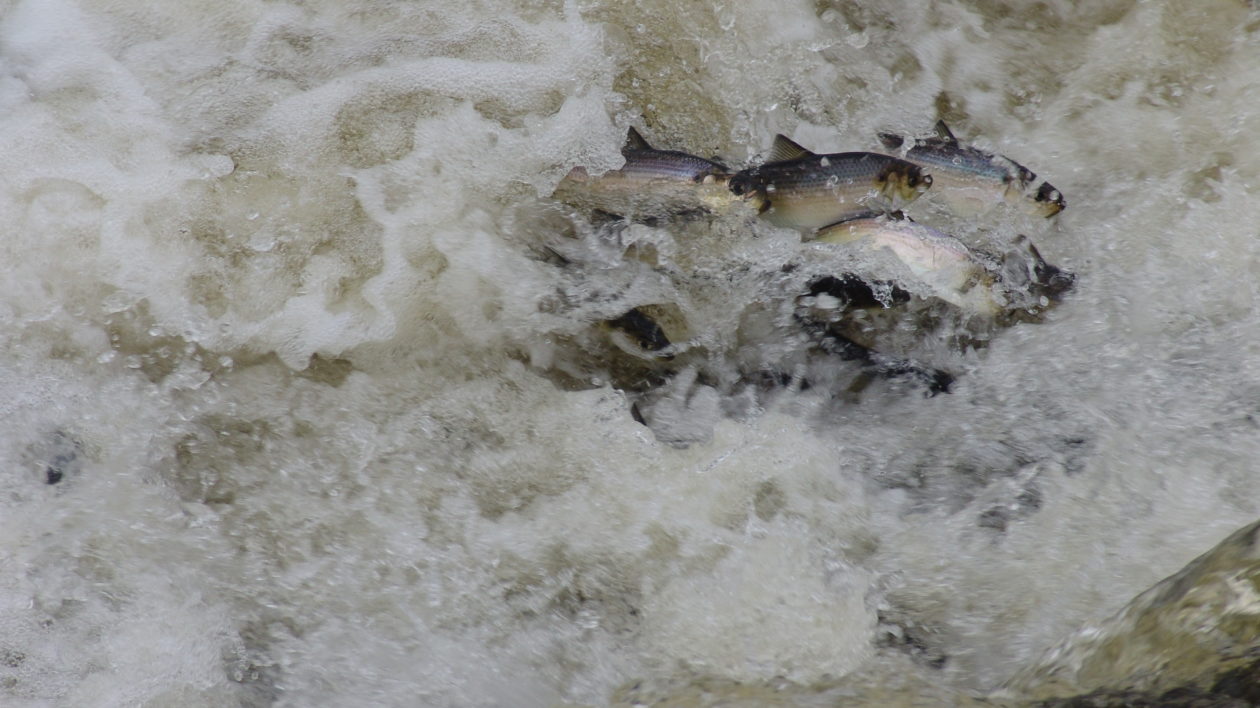
The Outlaw Alewife
One tends to refer to alewives in the past tense, but that usage is no longer appropriate in Maine — the state with more potential alewife spawning and nursery habitat than all others combined and the one state that is having spectacular success at recovery.
It has not been easy. On the St. Croix River, which defines part of the border with New Brunswick and has the potential to support a run of 22.7 million alewives (more by far than any other Maine river), improved fish passage at the Milltown dam in 1981 allowed large numbers of alewives to make it as far as Spednic Lake. They arrived after several years of drought and just as a water draw-down for downstream hydro generation exposed redds of alien smallmouth bass, shutting down bass recruitment.
To local guides in the Grand Lake Stream area there was only one explanation for the lousy bass fishing that ensued — alewives. This despite the fact that in all other systems where native alewives intermingle with alien bass the bass do just fine, in fact better because of the rich food source.
Outdoor editor John Holyoke of the Bangor Daily News responded as follows: “Primitive people believed that trees caused the wind to blow. Every time the wind blew, the branches were flapping back and forth. The harder the branches flapped, the harder the wind blew.” Obvious solution: cut down the trees.
So in 1995 the local guides prevailed on the Maine legislature to outlaw St. Croix alewives. Accordingly, the state blocked the run with boards at Woodland and Grand Falls dams, an action that outraged the Canadians and violated a joint management agreement.
Leading the charge for the anti-alewife law on behalf of the Grand Lake Stream Guides Association was the governor-appointed advisor on fish and wildlife policy — state Rep. Albion Goodwin (D-Pembroke). When I interviewed him in 2002 he offered this: “They [alewives] are trash fish…. I told those sons of bitches [the Canadians] to build a fishway on their side of the river. I sent ’em all packing: ‘Get the hell out of Calais before I have you run out as terrorists.’ And away they went a-running.”
The Grand Lake Stream guides still embrace their superstition. But as alewives recover elsewhere in the state the ecological and economic importance of these little fish is being recognized by other guides, anglers, the general public and legislators. For example, the Passamaquoddy Indians, who were instrumental in shutting down the St. Croix run, now treasure alewives as part of their heritage and are instrumental in their recovery. And the Kennebec Water District, which draws drinking water from China Lake for the cities of Winslow and Waterville, has reversed its position opposing alewife access to the lake now that water with restored alewife runs is getting cleaner. The fry, which gorge on zooplankton, store phosphorus, exporting it to the sea.
In 2008 Maine lawmakers voted to allow alewife passage at Woodland, but this opened only two percent of traditional habitat. Then, on April 10, 2013, the legislature overwhelmingly passed a bill to remove the boards at Grand Falls. This past April, when the Grand Lake Stream guides got a bill introduced to again block St. Croix alewives, it was unanimously shouted down by the Marine Resources Committee.

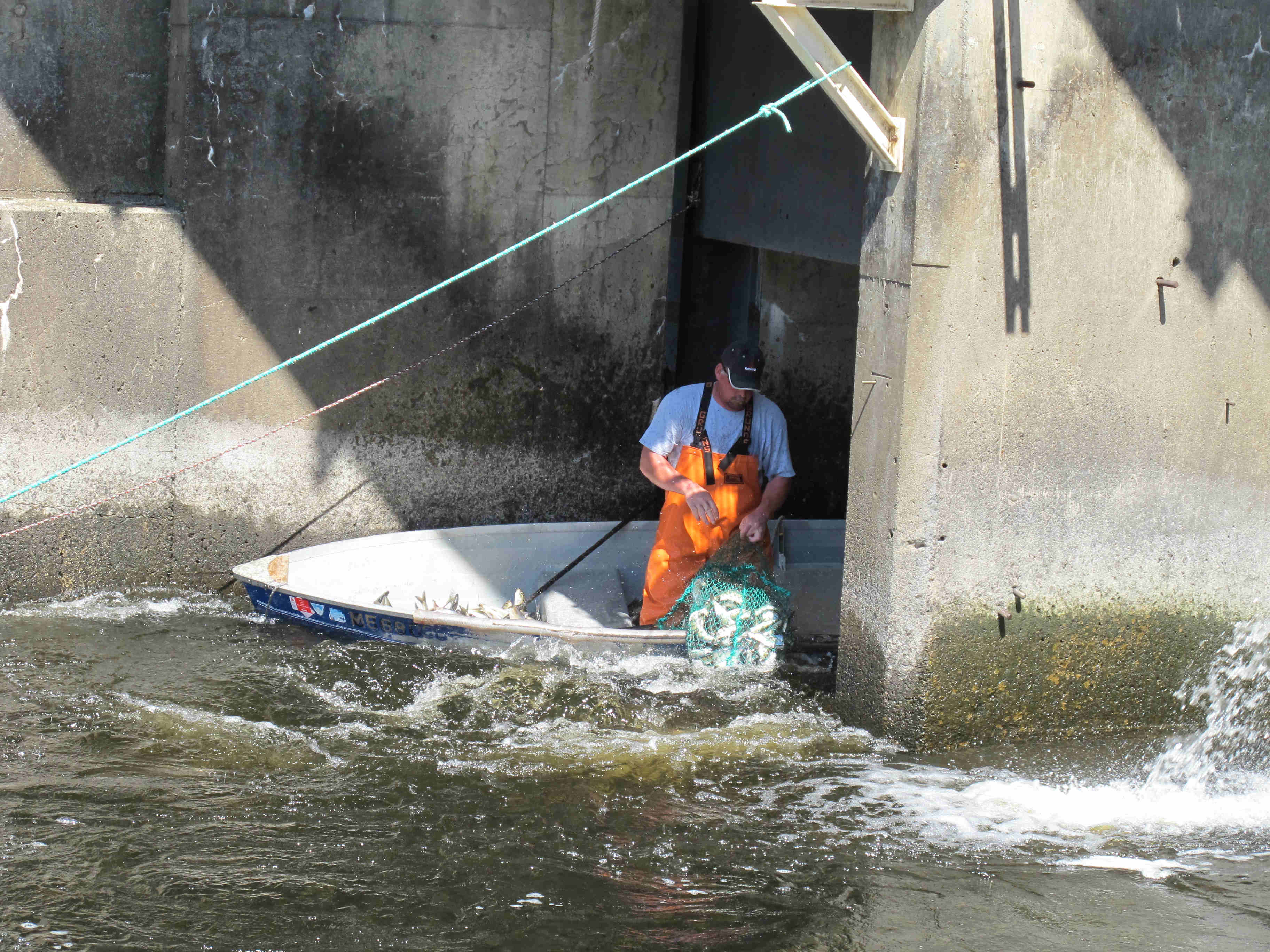
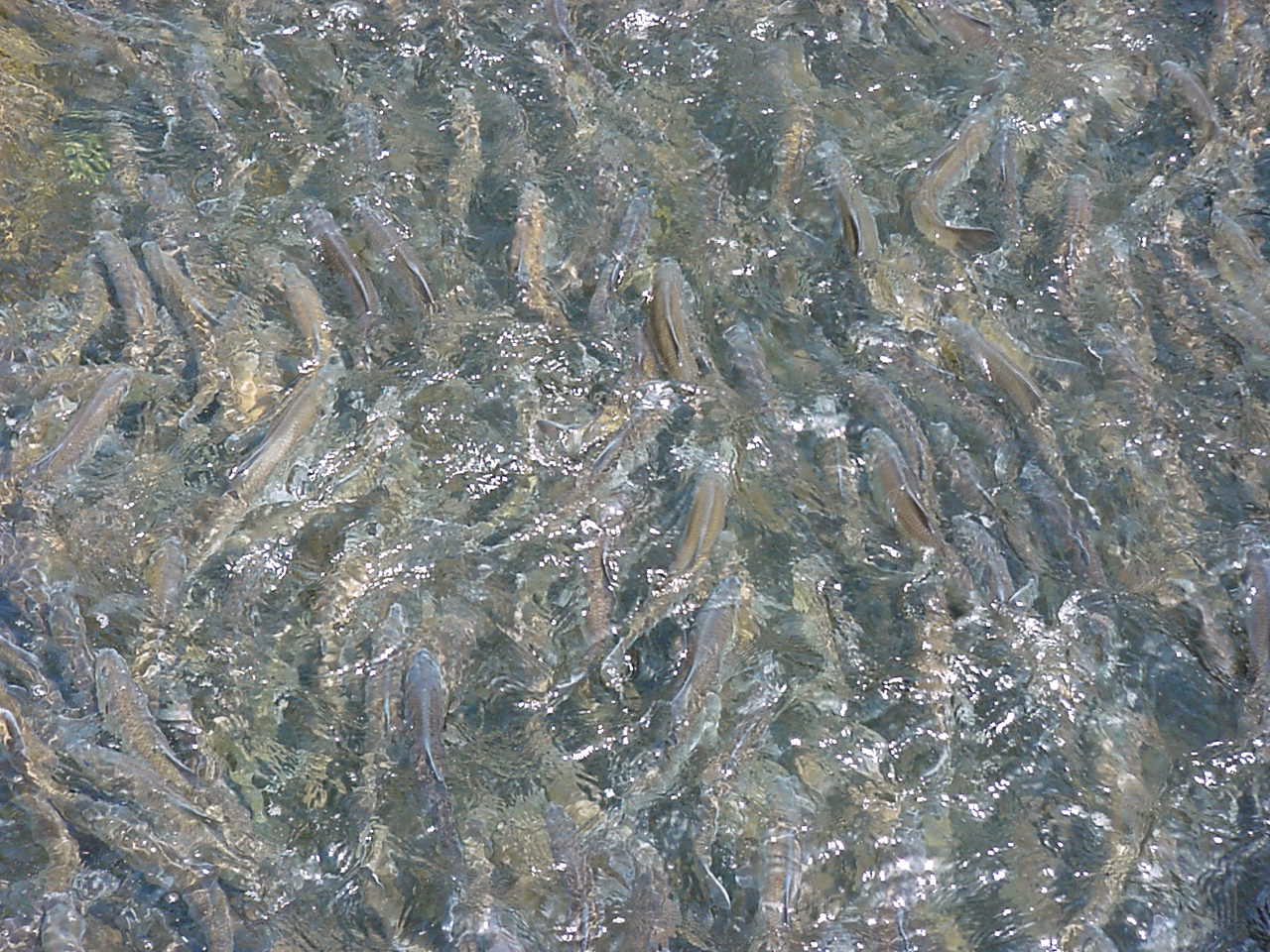
Bringing Back the Alewives
Alewives are pouring back into the St. Croix system, but it’s too early to quantify the ecological response. Not so on the Sebasticook, a major tributary of the Kennebec. Florida Power and Light decided it was too expensive to construct required fish passage at its low-production, century-old Ft. Halifax hydro dam in Winslow.
So in 2008 it tore the dam down — this after a vicious fight with landowners who wanted to keep their docks and shorelines and bass anglers who wrongly imagined that smallmouths, best adapted to running water, do better in impoundments.
Now alewives (along with blueback herring, American shad, striped bass, Atlantic salmon, Atlantic sturgeon, eels, white suckers, lampreys and brook trout) have access to much of their historic spawning grounds in the 1,000-square-mile watershed.
The Sebasticook’s alien smallmouth bass grow to trophy size, and they’re more prolific than ever. “At the Benton Falls fish lift [constructed in 2006] they’ve learned a new behavior that allows them to take advantage of the alewives and blueback herring,” says biologist Nate Gray of the Maine Department of Marine Resources. “They will turn around, face downstream, lock themselves to the bottom, then nail the fish as they ascend. The size of the [native-fish] migration is epic.”
The Sebasticook now has the biggest alewife run in the U.S. (though the St. Croix will probably exceed it, if the Grand Falls fishway gets a makeover). This past spring 2.1 million alewives were lifted over the Benton Falls dam.
In the next few years at least two and probably three of the six dams blocking Sebasticook alewives from China Lake will come down; and the other three will get fish passage. “We’ll then be looking at an additional run of well over one million fish,” says Gray.
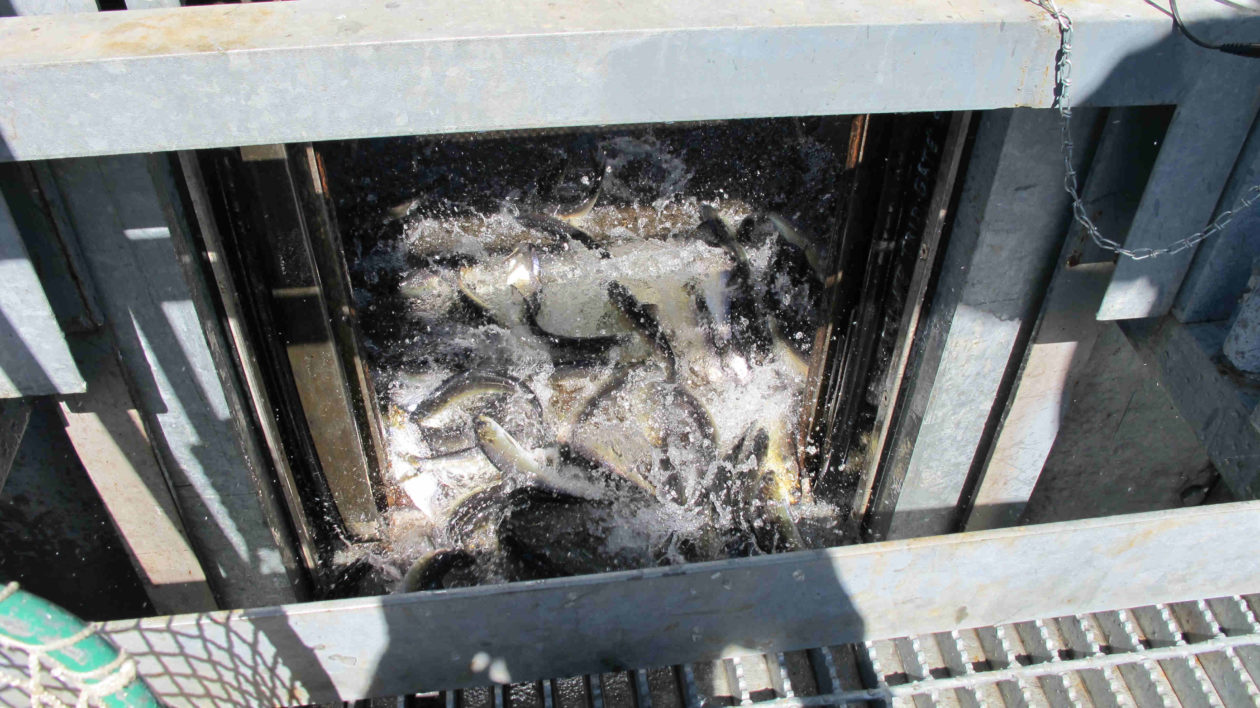
Sebasticook alewives and blueback herring, their close cousins, are drawing fish-eating birds from all over the Northeast. On a single day in June 2014 observers stationed in the five-mile stretch between Benton Falls and the confluence of the Kennebec counted 64 bald eagles, the largest aggregation in New England.
When a quarter million alewives have gone over the Benton Falls dam the Department of Marine Resources allows limited harvest on the downstream side. Usually around 200,000 fish (five to eight percent of the run) are taken, virtually all for lobster bait.
“Without alewives, the lobster industry would crash,” says Jeff Pierce, director of the Alewife Harvesters of Maine. There’s no other bait available in the spring. Lobstering is the only [fishing] industry left in the state. We’ve effectively killed everything else. You can track the crash of Maine alewives with the crash of our ground fish. Without alewives, you’re never going to have cod recovery. There were millions of alewives in the St. Croix, and the legislature decided to extirpate them because of these fools at Grand Lake Stream. You talk about destroying an ecosystem.”
Pierce, also a state representative who serves on the Marine Resource Committee, was “delighted” to lead the squashing of this year’s bill to again interdict St. Croix alewives.
Alewives are surging back elsewhere in Maine now that useless dams are being removed and productive ones bypassed by fish lifts and ladders. “The Penobscot [New England’s second biggest river system] is about to explode,” declares Bucky Owen, former commissioner of the Maine Department of Inland Fisheries and Wildlife.
Throughout their range alewives were, as Aldo Leopold wrote of passenger pigeons, “the lightning that played between two opposing potentials of intolerable intensity” — in this case, fat of the sea and the rush of freshwater from Eastern highlands.
But, unlike passenger pigeons, we can have alewives back. Maine is proving it.
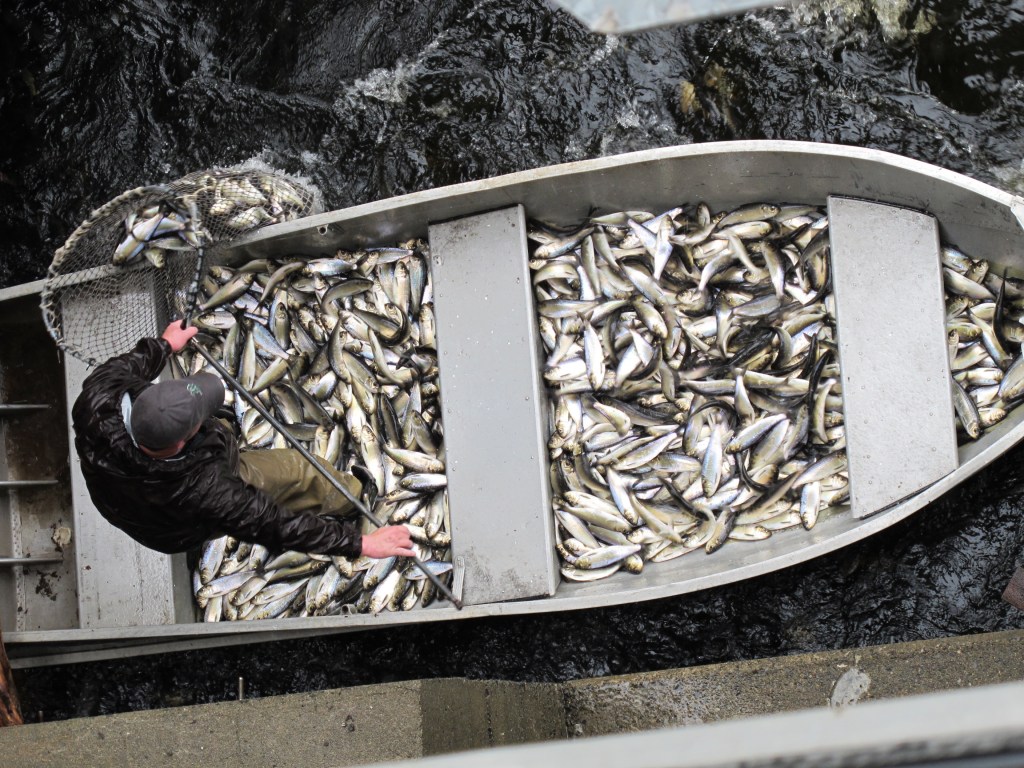



I only wish all the facts were available when the decision was made to allow this. From what I read alewives never got above salmon falls as the natives harvested them with ease. Only salmon could make the leap and get above the falls. Not sure who is to gain from this but we’ll all watch as the last, and best landlocked salmon strain is ruined at Grand Lake Stream. What a shame it is to allow this to happen only so few can gain.
Bet you wont research this, or maybe your the one gaining. Another example of politicians and people in certain positions basically steal and rob at will.
Great article! I’ve seen the results in Gardiner,and Webber pond . What I Do not understand is why the state of Maine will. Not allow live Maldives be used as bait.there is no way we will endanger the species. Sounds to me that politics has slipped into that issue likely the bass tournament lobby ?
Your quote “Conservation is not enough …need to restore what is lost” is fundamental to sustaining water for human use, and for sustaining wetlands. Many watersheds have experienced changing land uses, removal of natural lands, and more important impairment of the soil ecosystem beneath natural lands. This critical soil ecosystem is key to sustaining baseflows and wetlands. Rainfall in woodland soils is rapidly infiltrated deep into the soil supplying ground water supplies and providing critical freshwater baseflows to,our streams, estuaries and wetlands. Unfortunately when we clear, grade, cut, fill and other disturbances in construction we permanently crush soil pores. These pores are essential to filtering, storing and releasing water deep into our soil profiles. Following development this essential soil ecosystem is so,impaired we begin to witness flooding of roads, soggy, saturated lawns that won’t readily drain and results in excessive Stormwater runoff. This is not a local problem it is uniqutious. I spent decades assessing soil functions in coastal plain states, witnessed these same problems in numerous states and also in travels to China, Switzerland, France and Middle East countries.
Healthy, functional soils are at the root of everything. When agencies and NGOs purchase and preserve natural lands let’s not forget that those important lands are permanently preserved…AND they permanently preserved the soil ecosystem below!
Its about time someone wrote an article like this.
The importance of these fish has never been written about.
There affect on the environment and importance to game fish and there impact.
Ted needs to write more articles like this.
We have big problems with alewife conservation in Connecticut. We were the first state to shutdown our harvest due to dramatic declines after the mid-1980s. We continue to build fishways and take out dams (we’re taking out six dams this summer/fall) and our freshwater habitat is in good condition. But the runs continue to decline. The runs in 2015 were the worst on record (and therefore probably the worst in history). Connecticut and Rhode Island. The cause must be at sea and likely related to bycatch in the Atlantic herring fishery off Block Island and the eastern end of Long Island. Yet, the New England Fishery Management Council just voted to raise the catch cap on shad and river herring in southern New England, which will put more stress on the runs. The success story of the Sebasticook and other runs in Maine have some managers thinking there are no problems with river herring and who cares about a little bycatch. They fail to appreciate there are different stocks of river herring along the coast and they are subject to different localized pressures, including bycatch in localized fisheries.
Very good news indeed, even if I know very little about fishing. Restoring, reviving, good stuff, thanks for the article. One thing, you squash bugs and quash bills, fines… 🙂